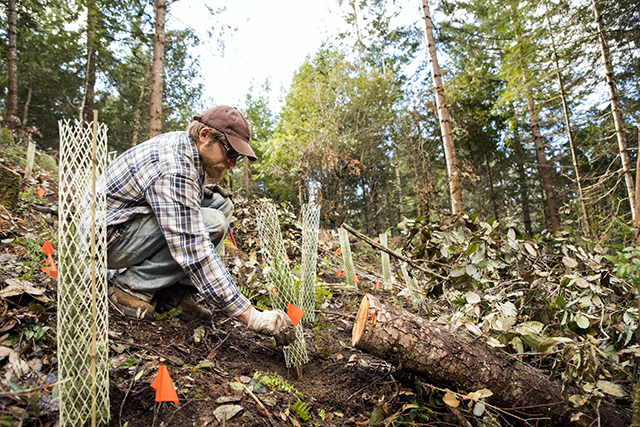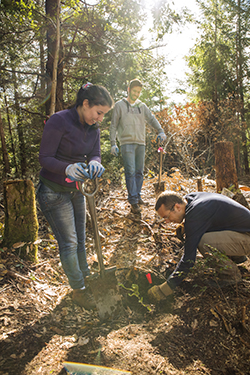
“Making it patchy like this is a novel approach to managing a forest,” says Pascal Berrill, Humboldt State professor of Forestry & Wildland Resources. “Cutting only the trees that you don’t want and leaving the more valuable trees standing is counter to common practice.”
Berrill’s students in the Forest Restoration class are testing that concept, one that thins out deciduous trees like tanoak, making more nutrients available for higher-quality wood produced by Douglas-fir and redwood trees. They’ve spent several Saturdays at Humboldt State’s Schatz Demonstration Tree Farm during the spring semester, applying their muscles and their minds to the project.
“Before they’re writing management plans for 10,000 or 100,000 acres, it’s better for future foresters to experience the process by doing it,” Berrill says. “I can talk about it all I want in the classroom, but these students will remember it.”

Located 24 miles of slow-driving, winding road from the HSU campus, the Schatz Demonstration Tree Farm provides the excellent laboratory for Berrill’s students, along with others taking classes as diverse as Soil Science, Tree Physiology, and Fire Management. Many of the classes utilize portions of the 385-acre site, donated to the university in 1987 by L.W. Schatz.
Since arriving at HSU seven years ago, Berrill has utilized the farm’s resources to benefit both undergraduate and graduate students.
“I’ve designed these restoration projects so they can be studied,” he says. “This is going to be a master’s thesis once they’ve grown a bit. Probably a couple of master’s theses.”
During a recent Saturday session, students carefully removed the marked trees from a 1 ½-acre plot of land, the growl of chainsaws limiting conversation. Other students rolled logs down the hill to another crew that formed a human chain, tossing timber to one another on the way to a truck waiting on the dirt road below.
The resulting load of small logs doesn’t go to waste. After leaving the farm, it’s used by the HSU Logging Sports club for practice and competition, eventually becoming firewood. That final step generates funding for a department scholarship fund.
As the clearing process slowed down, many of the 48-student workforce, comprised of students enrolled in Berrill’s two class sections, turned their attention to planting. Berrill demonstrated the process he learned while attending college in his native to New Zealand. Tree planting experience has helped Berrill teach it, and he wants his students to teach others well in future.
“Clear the organic material and get down to the mineral soil,” explained Berrill, who paid for his undergraduate education working as a tree planter. “I want to cultivate the soil anyway I can, dig a hole, plant a little tree, and move the soil back in. We want to make the soil pop up, break apart. I want my little roots spreading out into cultivated soil. This is forestry.”
Following their teacher’s lead, students got busy planting 20 redwoods and 15 Douglas firs in each 1/10th-acre parcel within the plot. After covering the root system with rich soil, they tamped it down, leaving a little ring for water catchment. The Douglas-fir seedlings—a tasty favorite of deer—are surrounded by a protective ring of mesh anchored in place by a small biodegradable bamboo pole.
“Working out here, we’re not only learning about forest management, but also about watersheds and the entire ecosystem,” says Quentin Matilton, a junior Environmental Science major from nearby Hoopa, Calif. “I want to take what I learn here and apply it in my community.”
Berrill continued his instruction as students listened attentively. “Make sure you get the bamboo in there really deep and that it weaves through the mesh several times so it’s held tight. We want to protect the little guy because the deer wants the nutritious seedling.”
While the project is focused on efficient, sustainable forest management for economic purposes, its scope has multiple educational applications. Students from a variety of disciplines are typically attracted to the class.
“Pascal is very knowledgeable and has a light hearted sense of humor that makes his lectures engaging and open for participation,” said Salvador Silahua, an Environmental Restoration student who will graduate in the fall. “His labs and field trips get us outside and allow us to learn by doing. We work in small, interdisciplinary groups and we all learn from each other. “
“Some students are more production oriented, and some are more interested in restoring degraded forest systems,” Berrill says. “Both are important objectives that require care and creativity, and combine well. Deriving product and revenue can be a benefit of restoration thinning in crowded fire-prone forests.”